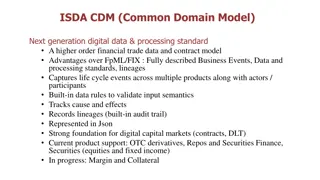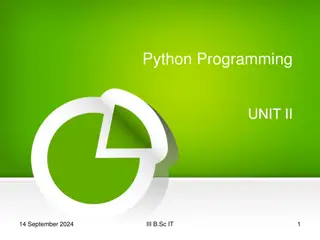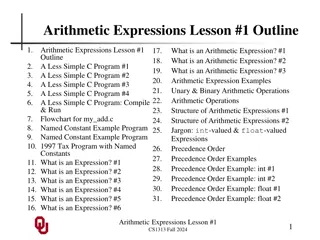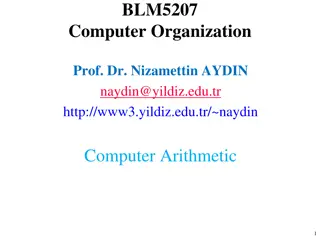Understanding Arithmetic and Logic Computing in CdM-8
Explore the fundamental concepts of arithmetic and logic computing, including conditions, branches, arithmetic instructions, logic instructions, shift and move instructions, and the practical applications of shift operations. Delve into CdM-8 flags semantics, C and unsigned subtraction/comparison, branch instructions, and more about branches in typical assemblers. Uncover the rich syntax of CdM-8 assembler in this insightful learning material.
Download Presentation

Please find below an Image/Link to download the presentation.
The content on the website is provided AS IS for your information and personal use only. It may not be sold, licensed, or shared on other websites without obtaining consent from the author. Download presentation by click this link. If you encounter any issues during the download, it is possible that the publisher has removed the file from their server.
E N D
Presentation Transcript
Lecture 3 Conditions and branches Arithmetic and logic Computing platforms Novosibirsk State University University of Hertfordshire D. Irtegov, A.Shafarenko 2018
Where shift operations are used? Multiplication/division by powers of 2 [Parts of algorithms for] multiplication/division by arbitrary number We will discuss this later today Bit arrays and sets We will discuss this next week Data structures with fields not aligned to byte boundary Say, we need to encode two numbers, one 0..1023, second 16..47 UTF-8 and many compressed data formats Communication protocols (transmit data one bit a time)
CdM-8 flag semantics N sign bit of the result. Used for signed comparison C carry bit of the result. Used for unsigned comparison Z result is zero. Used for signed, unsigned and bitwise comparison V signed overflow (sign loss). Can be used to catch errors V is also needed for correct signed comparison
C and unsigned subtraction/comparison again Subtraction adding 2 complement When the result < 0, C is 0 1-255 = 1+0000 0001 = 2 When the result > 0, C is 1 3-2 = 11+1111 1110 = 1+C
More about branches In typical assembler, branch is like goto statement. You must invent label names and jump to labels Typical equivalent of if (condition) { then-block } else {else-block) requires one comparison, two labels, one branch and one jump (unconditional branch) Condition calc b[!cond] $1 Then-block Br $2 $1: Else-block $2:
CdM-8 assembler has richer syntax If Calc condition is cond Then-block Else Else-block Fi
Real example if tst r0 is z ldi r1, 10 add r1, r0 else shla r0 fi Consult tome.pdf for syntax for complex conditions (it is not so elegant)
Loops # r2=r0*r1 (assuming r1 is non-negative) clr r2 while tst r1 stays gt add r0, r2 dec r1 wend
Post-condition loop # find a zero ldi r0, array-1 # Initialise r0 to point to the cell before the first element of the array. do inc r0 # point r0 to the next element ld r0, r1 # read the element into r1 tst r1 # examine it until z # if r1 is 0 then exit, otherwise continue
Nesting of ifs and loops is possible You can use them like blocks in high-level languages You do not need to invent label names You do not need to worry about correct nesting Much harder to write spaghetti code (than with raw branches) This is why CdM-8 assembly is called Platform 3 Actually, it is much simplier to implement than you probably think It is all described in tome.pdf Beware: in some exercises using structural statements is explicitly prohibited























